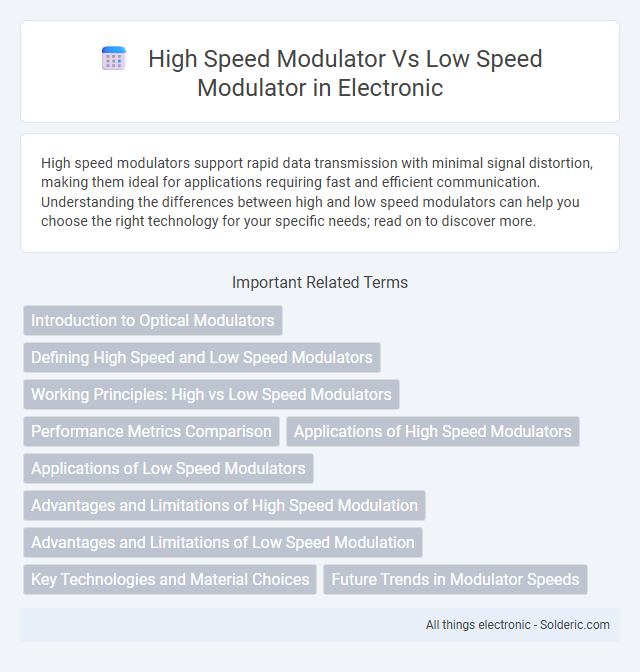High speed modulators support rapid data transmission with minimal signal distortion, making them ideal for applications requiring fast and efficient communication. Understanding the differences between high and low speed modulators can help you choose the right technology for your specific needs; read on to discover more.
Comparison Table
| Feature | High Speed Modulator | Low Speed Modulator |
|---|---|---|
| Operating Frequency | Above 1 GHz | Below 100 MHz |
| Modulation Bandwidth | Wide bandwidth (several GHz) | Narrow bandwidth (up to 100 MHz) |
| Applications | Optical communications, high-speed data links | Audio signals, low-speed data transmission |
| Response Time | Nanoseconds to picoseconds | Milliseconds to microseconds |
| Complexity | High complexity, expensive components | Simple design, cost-effective |
| Power Consumption | Higher power consumption | Lower power consumption |
| Signal Integrity | Better suited for high data rates with minimal distortion | Limited by slower response, more noise |
| Examples | Electro-optic modulators, microwave modulators | Mechanical modulators, audio modulators |
Introduction to Optical Modulators
Optical modulators control light intensity, phase, or polarization in fiber optic communication systems, with high speed modulators enabling data transmission rates exceeding tens of gigabits per second essential for modern telecommunication networks. Low speed modulators operate at slower rates, suitable for simpler applications like sensing or signal processing, where bandwidth demands are less stringent. The choice between high and low speed modulators depends on factors such as modulation bandwidth, insertion loss, and drive voltage compatibility with system requirements.
Defining High Speed and Low Speed Modulators
High speed modulators operate at frequencies typically above several gigahertz, enabling rapid signal switching and data transmission essential for advanced telecommunications and high-frequency applications. Low speed modulators function at much lower frequencies, often below a few megahertz, suitable for applications requiring less bandwidth and simpler signal modulation. Your choice between high speed and low speed modulators depends on the required signal rate and the specific demands of your communication system.
Working Principles: High vs Low Speed Modulators
High speed modulators operate by rapidly varying a carrier signal's amplitude, frequency, or phase to encode data, enabling transmission at rates often exceeding several gigahertz for applications requiring swift signal processing. Low speed modulators modulate signals at slower rates, typically in the kilohertz to low megahertz range, suitable for applications where bandwidth efficiency and lower power consumption are prioritized over speed. Understanding these working principles helps you choose the right modulator type based on the required data rate, system complexity, and application needs.
Performance Metrics Comparison
High speed modulators typically offer higher bandwidth and faster switching times, enabling superior signal fidelity and reduced latency in high-frequency applications. Low speed modulators exhibit lower power consumption and improved noise performance, making them suitable for energy-sensitive or low-bandwidth systems. Performance metrics such as modulation bandwidth, power efficiency, linearity, and signal-to-noise ratio distinguish the suitability of each modulator type for specific communication or sensing tasks.
Applications of High Speed Modulators
High speed modulators are essential in applications requiring rapid data transmission and precise signal control, such as optical communication systems, LiDAR technology, and high-frequency radar. These modulators enable real-time processing of large bandwidths and support advancements in 5G networks and quantum computing. Your choice of a high speed modulator significantly impacts system performance in ultrafast signal modulation scenarios.
Applications of Low Speed Modulators
Low speed modulators are widely used in applications requiring simple signal processing and low bandwidth, such as audio transmission, sensor data modulation, and amplitude modulation for broadcasting AM radio signals. Their design prioritizes power efficiency and low cost, making them ideal for battery-powered devices and IoT sensor networks. These modulators support reliable communication in environments with minimal interference and slower data rate requirements.
Advantages and Limitations of High Speed Modulation
High speed modulators enable rapid data transmission with higher bandwidth efficiency, making them ideal for applications requiring real-time processing and minimal latency, such as 5G networks and advanced optical communications. Their limitations include increased power consumption and complexity in design, which can raise costs and heat dissipation challenges. Understanding these trade-offs helps you select the right modulator for your specific high-speed communication needs.
Advantages and Limitations of Low Speed Modulation
Low speed modulators offer advantages such as simplified circuit design, lower power consumption, and reduced signal distortion, making them suitable for applications where high-frequency bandwidth is not critical. However, their limitations include slower data transmission rates and limited ability to handle complex modulation schemes, which can restrict performance in high-speed communication systems. Your choice of modulator should consider these trade-offs based on the required signal bandwidth and system complexity.
Key Technologies and Material Choices
High speed modulators utilize advanced materials like lithium niobate and indium phosphide to achieve rapid signal modulation with minimal latency, essential for high-bandwidth optical communication systems. Low speed modulators often rely on more cost-effective materials such as polymers or silicon-based technologies, prioritizing energy efficiency and integration over speed. Your choice between these modulators depends on whether ultra-fast response times or cost-effective, power-efficient performance aligns better with your application requirements.
Future Trends in Modulator Speeds
High-speed modulators are advancing rapidly with innovations in materials like lithium niobate and silicon photonics, enabling data rates exceeding hundreds of gigahertz for applications in 5G, data centers, and quantum computing. Low-speed modulators continue to be refined for energy efficiency and cost-effectiveness in IoT devices and automotive sensors, where moderate bandwidth suffices. Future trends emphasize integrating high-speed modulators with AI-driven adaptive control systems to optimize performance and reduce latency across diverse communication networks.
High speed modulator vs low speed modulator Infographic

 solderic.com
solderic.com